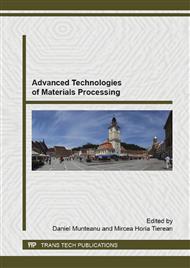[1]
P.K. Chu, X. Liu, editors. Biomaterials Fabrication and Processing Handbook. CRC Press, Taylor & Francis Group, Boca Raton, (2008).
Google Scholar
[2]
F. Barrere, T.A. Mahmood, K. de Groot, C.A. van Blitterswijk, Advanced biomaterials for skeletal tissue regeneration: Instructive and smart functions, Mat Sci Eng R. 59 (2008) 38-71.
DOI: 10.1016/j.mser.2007.12.001
Google Scholar
[3]
K. Duan, R. Wang, Surface modifications of bone implants through wet chemistry, J Mater Chem. 16 (2006) 2309-2321.
DOI: 10.1039/b517634d
Google Scholar
[4]
M. Zilberman, J.J. Elsner, Antibiotic-eluting medical devices for various applications, J Control Release. 130 (2008) 202-215.
DOI: 10.1016/j.jconrel.2008.05.020
Google Scholar
[5]
T. -F.C. Mah, G.A. O'Toole, Mechanisms of biofilm resistance to antimicrobial agents, Trends Microbiol. 9(1) (2001) 34-39.
Google Scholar
[6]
S. Radin, J.T. Campbell, P. Ducheyne, J.M. Cuckler, Calcium phosphate ceramic coatings as carriers of vancomycin, Biomaterials. 18 (1997) 777-782.
DOI: 10.1016/s0142-9612(96)00190-1
Google Scholar
[7]
V. Luginbuehl, L. Meinel, H.P. Merkle, B. Gander, Localized delivery of growth factors for bone repair, Eur J Pharm Biopharm. 58 (2004) 197-208.
DOI: 10.1016/j.ejpb.2004.03.004
Google Scholar
[8]
R. Cristescu, C. Popescu, A. C. Popescu, Popescu, G. Socol, I.N. Mihailescu, G. Caraene, R. Albulescu, T. Buruiana, D. Chrisey, Pulsed laser processing of functionalized polysaccharides for controlled release drug delivery systems: functionalized polysaccharides processed for drug delivery, NATO Science for Peace and Security Series A: Chemistry and Biology (2012).
DOI: 10.1007/978-94-007-2488-4_25
Google Scholar
[9]
A.J. Tasman, F. Wallner, R. Neumeier, Antibiotic impregnation of cartilage implants: diffusion kinetics of fluoroquinolones, Laryngo-Rhino-otologie 79 (2000) 30-33.
DOI: 10.1055/s-2000-8778
Google Scholar
[10]
C. Saviuc, A.M. Grumezescu, A. Holban, C. Chifiriuc, D. Mihaiescu, V. Lazar, Biointerface Res. Appl. Chem. 1 (2011) 64–71.
Google Scholar
[11]
C. Saviuc, A.M. Grumezescu, E. Oprea, V. Radulescu, L. Dascalu, M.C. Chifiriuc, M. Bucur, O. Banu, V. Lazar, Biointerface Res. Appl. Chem. 1 (2011) 15–23.
Google Scholar
[12]
E. Panus, C.M. Chifiriuc, O. Banu, M. Mitache, C. Bleotu, N. Rosoiu, V. Lazar, Biointerface Res. Appl. Chem. 1 (2011) 24–30.
Google Scholar


